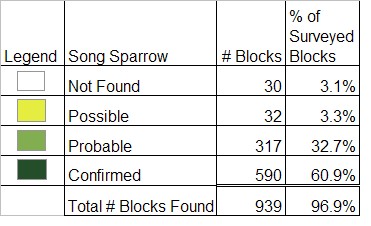Breeding Bird Atlases (BBA)
Find a Bird - BBA1
Breeding Bird Atlas 1 Species Accounts
Song Sparrow
Melospiza melodia
Egg Dates
April 30 to August 17
Number of Broods
two; possibly sometimes three

Though the Song Sparrow is one of the most common birds in Massachusetts, it is not very familiar to the general public. It is a widespread breeding species, occupying a variety of habitats from coastal dunes to river floodplains to forest edge. The common element wherever it is found is brushy, rank growth interspersed with grassy openings. Wet meadows and sites bordering water are particularly favorable. Although Song Sparrows are nearly ubiquitous, they are not found in forests or open fields. They adapt well to the disturbed habitats created by humans, and a glance at the accompanying map will show that they are as evenly distributed throughout urbanized eastern Massachusetts as they are on Cape Cod and the Islands and the uplands of the western sections of the state.
Song Sparrows are present in the state throughout the year, but the wintering population is sparse. The first spring migrants appear in early March, and, by the end of April, most residents are on well-established territories. The vocal effort of the Song Sparrow is such a simple roundelay that one wonders why the bird was so named. Perhaps it is the quantity, not the quality, of the song, because from March through the long nesting season the males sing frequently. Vocalization is most intense shortly after the males begin to establish territories but continues well into August. Simple though it may be, the basic song has apparently endless variations that consist of short notes, often with a trill at the end or inserted in the middle of the song. Over 50 variations have been recorded or described in the literature, and each male may use several different versions of song. The common call notes of both sexes are a sharp chimp and a sibilant tsst.
Territories are generally small (usually less than an acre), and males defend them by singing from perches, by performing a stiff-winged flight, and by chasing and fighting, with much excited chipping. During courtship, the females may be chased. The nest, a cup of leaves, grass stems, and strips of bark lined with fine grasses or hairs, is constructed by the female on the ground, generally within a clump of weeds or dead grasses, or deep within small bushes or conifers a few feet high.
Nesting habitats for 19 Massachusetts sample nests were suburban (6 nests); urban (2 nests); old field (3 nests); wood edge (2 nests); cemetery, pond border, marsh, power line, beach dune, and mowed dike (1 nest each) (CNR). Bent mentions a nest found in a salt marsh in Gloucester (ACB). Other Massachusetts nests have been located on bare ground, on the ground in grass, in weed clumps and Timothy, and in bushes, evergreen shrubs, Red Cedar, Pasture-juniper, Arbor Vitae, viburnum, rose, cultivated hedges, raspberry, blackberry, and English Ivy (CNR, Meservey). A Brookline nest discovered on the ground under a brush pile was constructed of dried grasses and was lined with loose hair. Heights for 23 state nests were ground (9 nests), 1 foot (2 nests), 2 feet (3 nests), 3 feet (3 nests), 4 feet (3 nests), 5 feet (2 nests), 7 feet (1 nest) (CNR, Meservey).
The female incubates the three to six eggs for 12 to 13 days, and the August egg dates indicate that there may be three broods in a season. A clutch of five eggs in a North Adams nest was laid from May 4 to May 8 (CNR). Clutch sizes for 27 state nests were three eggs (2 nests), four eggs (7 nests), five eggs (17 nests), six eggs (1 nest) (DKW, CNR, Meservey). Both parents feed the young, which have sparse natal down at hatching. Their eyes open at 3 or 4 days, they begin to preen the developing feathers on day 5, and by day 7 they perch alertly on the nest rim. By day 8 or 9, they are quite active and exercise their wings. They fledge in about 10 days, generally before they can fly, and are fed until they are 28 to 30 days of age. If a subsequent nesting begins, the care of the young falls to the male while the female lays another clutch in the same or a new nest. Brood sizes for 14 Massachusetts nests were two young (1 nest), three young (4 nests), four young (6 nests), five young (3 nests). Confirmed fledging dates were June 27 and July 4, 25, and 26 (CNR, Meservey). The egg dates indicate that the ranges for both nestlings and fledglings are greater. The outcomes for 20 sample state nests were unknown (5 nests), failed (7 nests), young fledged (8 nests) (CNR).
By late summer, scattered groups are encountered about weedy patches and are composed largely of birds in juvenal plumage. These immatures resemble the adults but are more finely streaked below and lack the characteristic central breast spot. Juvenile Swamp and White-throated sparrows, which often frequent the same habitats, share a plumage nearly identical with that of young Song Sparrows. The adults have a complete molt during August and September.
In September and October, Song Sparrows congregate at field edges and other locales where weed seeds abound. During Indian summer and also on mild winter days, muted and abbreviated songs are often heard. By the end of October, many individuals have migrated through and out of our area for wintering grounds in the southern United States. Some birds apparently remain on or near their territories all winter. Wintering birds may appear at feeders anywhere in the state but are most common in interior river valleys and milder coastal regions.
Map Legend and Data Summary
Atlas 1 data collected from 1975-1979


Note: common throughout the state in thickets, brushy fields, and woodland edges
Richard A. Forster



